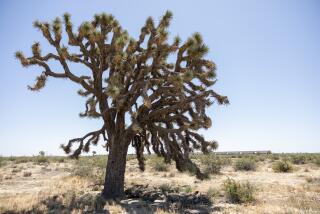GARDENING : Native Plants Can Stand the Heat : Desert Vegetation Needs Little Water and Fertilization
- Share via
Unless they know better, many people presume the soils of the Southwest deserts are lacking in nutrients that plants need. In fact, of the 16 elements known to be essential for plant growth, the sparsely vegetated land is usually deficient only in nitrogen.
Water, of course, is the landscape’s missing ingredient.
So it’s not surprising that desert-native plants, once established, use water sparingly in home landscapes. They evolved over the centuries by surviving arid conditions.
But gardening newcomers often go astray by not also understanding that fertilization needs of the native plants are quite low. They are well adapted to extracting nutrients from their environment.
Experts advise letting the plant tell you whether it needs fertilizer. If it’s giving the kind of growth and appearance you want, it probably doesn’t need any. If it’s not growing the way you want, a little fertilizer might help, but the emphasis is on little.
Because nitrogen is the one element consistently missing in desert soils, how is it possible the native plants get enough naturally? Actually, their normal foliage drop contains nitrogen, and it’s recycled into the soil. It’s not 100% recycling, but it’s a very high percentage.
Novices frequently are advised to forget what they know about plants until they are sure it works in this new environment. They also are advised to use plants adapted to alkaline conditions even if this rules out longtime favorites.
Many non-native plants, such as eucalyptus, become afflicted with iron chlorosis after a few years in alkaline soils. Iron is one of several micronutrients that become insoluble and thus unavailable to plants in soils with high pH. So do manganese and zinc. Acidifying the soil with sulfur products brings the pH down and helps to solubilize these nutrients.
Ammonium sulfate, which contains 21% nitrogen, is an inexpensive fertilizer and often recommended since its 24% sulfur-content also tends to lower pH. However, the amount required surprises novices.
The usual recommendation is to apply, once a year, one-fourth to one-half cup of ammonium sulfate to a good size shrub, scattering it on the ground under the leaf canopy.
Horticulturist Charles Sacamano, now retired from the Cooperative Extension Service at the University of Arizona, years ago did a definitive study on fertilizer needs of acacias, a group of shrubs and trees that satisfy a broad range of desert landscape needs, offer enormous eye-appeal and require little maintenance and water.
“Acacias have no special nutrient needs and grow well in most well-drained Southwest landscape soils,” Sacamano reported. “For sustained vigorous growth and heavy flowering, fertilize established trees in mid to late winter with any nitrogen-containing fertilizer. Apply at the rate of one pound of actual nitrogen per 1,000 square feet of area beneath the spread of branches. . . . If desired, a second application at the same rate can be made in early July.”
“Actual nitrogen” is a term often used in university calculations. It is calculated by dividing the nitrogen content printed on the bag by 100. Because ammonium sulfate has 21% nitrogen, it will take about five pounds of ammonium sulfate to produce a pound of actual nitrogen.
The Southwest’s alkaline soils result from high accumulations of salt levels. The low amount of rainfall prevents salts from being leached downward. And the high temperatures result in high evaporation rates from the soil, which moves salts upward. Therefore salts in the root zone can become concentrated at levels harmful to non-native plants.
Good drainage also is necessary for optimum growth of many plants, and poor water infiltration can occur in clay soils that are high in sodium. Sodium causes clay particles to disperse, destroying soil structure. Supplemental water applied to dispersed clay soils may literally stand above the soil surface, with much of it lost to evaporation.
Application of gypsum, which is calcium sulfate, is often recommended in this situation. It removes soil sodium by “replacing” it with calcium ions, improving soil structure.






